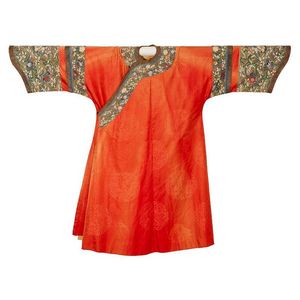Signed Japanese Kimono with Carriage and Flowers
You must be a subscriber, and be logged in to view price and dealer details.
Subscribe Now to view actual auction price for this item
When you subscribe, you have the option of setting the currency in which to display prices to $Au, $US, $NZ or Stg.
- Japanese Obi - The obi is a sash worn with traditional Japanese clothing such as kimono or yukata. The obi is usually wide, ranging from 10-30 centimeters in width, and can be several meters in length, depending on the style and the wearer's size. The obi is tied around the waist, with the ends wrapped around the body and tied in a knot at the back or the front, depending on the occasion and the formality of the attire.
The obi is an essential component of traditional Japanese clothing and is often made from luxurious fabrics such as silk, brocade, or embroidered cloth. It is available in a wide range of colors and designs, from simple and understated to vibrant and ornate, with patterns and motifs ranging from traditional Japanese symbols to modern designs.
The style and design of the obi can convey various meanings and indicate the wearer's social status, age, and gender. For example, a simple and understated obi may be worn for everyday wear, while a more ornate and elaborate obi may be worn for formal occasions such as weddings or tea ceremonies. - Lacquered Lacquerware - Lacquer is a clear or coloured resin that is obtained from the sap of several species of trees in the genus Rhus, particularly the Rhus verniciflua tree, which is native to China and Japan. The resin is harvested by making incisions in the tree bark and collecting the sap that oozes out.
The sap is then processed and refined through a series of steps, which may include filtration, heating, and chemical treatments. The resulting lacquer is a highly durable and glossy material that is used as a finish for furniture, musical instruments, and other objects.
Lacquer has been used for thousands of years in Asia, where it is valued for its beauty and durability. It is applied in multiple thin layers, with each layer being allowed to dry and harden before the next one is added. The process can take several weeks or even months to complete, but the resulting finish is incredibly hard, glossy, and resistant to scratches and wear.
The lacquer derived from the resin of the Rhus tree has been used for decoration of furniture in several countries in Asia, particularly China, Japan, Korea, and Vietnam. These countries have rich traditions of using lacquer for furniture decoration and have developed unique techniques and styles of lacquer work.
In China, lacquer has been used for furniture decoration for over 2,000 years, and it became a major art form during the Ming (1368-1644) and Qing (1644-1912) dynasties. Chinese lacquerware is known for its intricate carving, painting, and inlay work, as well as its use of bold colours and designs. Lacquer was used to decorate furniture such as cabinets, screens, and chairs.
In Japan, lacquer has been used for furniture decoration for over 1,000 years. Japanese lacquerware is characterized by its simplicity and elegance, and it often incorporates natural materials such as wood, bamboo, and shells. Lacquer was used to decorate furniture such as chests, cabinets, and trays.
In Korea, lacquer has been used for furniture decoration for over a thousand years. Korean lacquerware is known for its restrained and understated beauty, and it often features delicate patterns and designs that are achieved through careful layering and carving. Lacquer was used to decorate furniture such as cabinets, chests, and screens.
In Vietnam, lacquer has been used for furniture decoration for over 2,000 years. Vietnamese lacquerware is known for its vibrant colours and intricate designs, and it often features scenes from daily life, nature, and mythology
This item has been included into following indexes:
- Oriental textiles & costume, Japanese
Visually similar items

A Chinese red silk Kesi ladies Informal robe, 19th century, decorated with an evenly spaced monochrome pattern of round medallions, enclosing a pair of five-clawed dragons in profile contesting a flaming pearl, set against lotus scrolls. The border at the

Chinese Republic period high collared jacket, in black with blue silk lining, with applique trailing flowers and applique floral sprays, overall blue trim embroidered with flowers, in pastel tones

A dress by Hermes, styled in cream silk with pleated panel detail to front, labelled size 38

Ladies vintage purple and cream silk floral Kimono with embroidery
